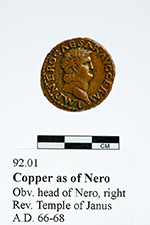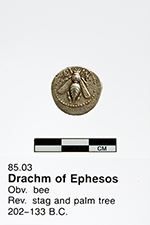Anyone wanting a short course on ancient Greek and Roman coinage should visit the Classics Museum to absorb the many lessons it has to teach .
A volunteer guide in the ANU Classics Museum and expert on coins, Dr Hugh Preston, points out that the museum has around 160 coins covering 900 years of the Greco-Roman world, from the early sixth century BC through to the end of the age of Constantine in AD 364.
The Greek collection covers Classical Greece and the Hellenistic kingdoms including the Seleucid kingdom and Egypt. The imagery on the coins includes the identifying emblems of the city states, portraits of the Hellenistic kings, and other images, such as those of gods and goddesses.
The Roman collection incorporates coins from the Republic and the Empire with emphasis on the High Empire. There are portrait coins of the twelve Caesars and the women of their families, depictions of mythical scenes, historical events, and political messages.
In Hugh’s words: “As time went on, ancient coins transmitted messages, public announcements, and political propaganda, commemorated historical events and victories, and also reinforced civic identity to their own citizens and foreigners.
“A collection of ancient coins like this presents a historical time-line showing civic identity and the evolution of imagery, particularly portraiture.
“The value of a coin is its eye appeal and the ease with which we can read it. These qualities depend on the engraver’s art, the accuracy with which the coin was struck, and, ultimately, its condition. The museum’s current project is to replace coins of a lesser grade with those of a higher grade.
“Our current collection comprises bronze and silver coins only. The collection would be enhanced considerably were we to include a coin in gold.”
A particularly useful addition would be a gold coin of one of the twelve Caesars, such as Tiberius, Caligula, Claudius or Nero, who ruled in volatile times. These coins were struck in high relief and offer fine examples of Julio-Claudian portraiture. Most of these, according to Hugh, were minted in Lugdunum (modern Lyon).
Hugh’s own interest in coins began as a child when his grandfather gave him a few 19th century coins. This gift led to him becoming a passionate collector of  Greek and Roman coinage. It is his hope that the ANU Classics Museum collection will find new audiences among students who are discovering Greek and Roman history through the prism of numismatics.
Greek and Roman coinage. It is his hope that the ANU Classics Museum collection will find new audiences among students who are discovering Greek and Roman history through the prism of numismatics.